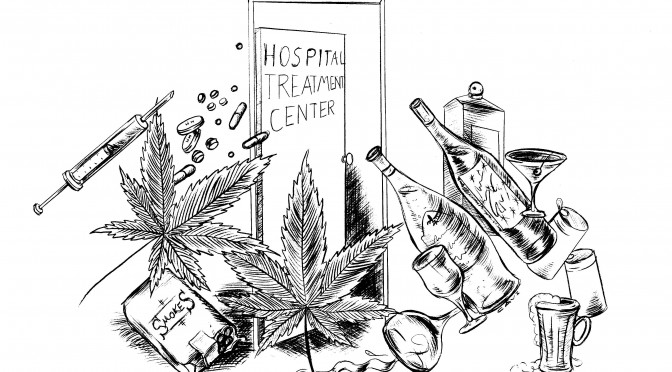For the first time, more Americans are using marijuana daily or near daily than are drinking alcohol daily. This monumental shift, spanning more than three decades, reflects the consequences of legalized recreational and medical cannabis.
The increase was foreshadowed by the alarming rise of daily teen pot use during the last decade.
In real terms, a much larger proportion of the US population drinks than uses cannabis. But the proportion of alcohol users who have a problem with it seems to be considerably smaller than the proportion of marijuana users with a Cannabis Use Disorder. Regular pot users are more likely wake-n-bake, while most daily drinkers don’t drink all day.
Rise in Daily Teen Marijuana Use
By 2016, daily pot use among high school seniors reached 6 percent. It has continued hover around 6 to 6.5 percent since time. In contrast, daily drinking by teens remains around 2 percent or slightly less.
When NIDA and University of Michigan’s Monitoring the Future Study demonstrated the rise in daily teen pot use, we sounded the alarm. Our warning in late 2016 was:
“Many of these young, habitual tokers, are potential addicts–if not yet addicted. They may stick to marijuana which is extremely potent today–5x more potent than it was in 70s. Or they may go onto other drugs, or slide into alcoholism as they turn the legal age to buy booze.” At the same time opioid and heroin use were going down with teens.
The number of drug overdose deaths have more than doubled since that time, now counting around 108,000 a year. How could this happen after Harm Reduction became widespread? One part of the answer is fentanyl, currently the main driver of the overdose crisis. But — as we’ve shown previously — many teens graduate directly from marijuana use to fentanyl. Often they don’t know what’s in the pill. Although marijuana lobbyists deny the gateway effect, marijuana remains the gateway for those who use other drugs and die from drugs.
Our warnings were prescient. Marijuana drives both the mental health crisis of today and the addiction crisis!
Concerning Numbers
According to a recent analysis of national survey data, conducted in 2022, an estimated 17.7 million people reported using marijuana on a daily or near-daily basis, compared to 14.7 million who reported similar levels of alcohol consumption.
This stark contrast marks a significant departure from 1992, when less than one million individuals reported daily marijuana use during a period of relative decline.
While alcohol remains more widely consumed overall, the emergence of daily marijuana use surpassing daily alcohol intake in 2022 is a watershed moment, as highlighted by Jonathan Caulkins, a leading cannabis policy researcher at Carnegie Mellon University.
Caulkins noted, “A notable 40% of current cannabis users are engaging in daily or near-daily consumption, a pattern reminiscent of tobacco use rather than traditional alcohol consumption.”
From 1992 to 2022, the per capita rate of reporting daily or near-daily marijuana use surged dramatically, increasing fifteen-fold. Although legalizers dress their arguments in political terms such as “freedom” and “regulation,” it’s entirely about using political donations to sway public opinion and create a new addiction industry.
Changing Attitudes
Caulkins acknowledged the possibility of heightened reporting as societal attitudes toward marijuana become more accepting, potentially inflating the observed increase.
In real terms there are far more users of alcohol in the USA than cannabis users (65-69% of adults used alcohol at least once in the past year vs. 15-20% who used cannabis) According to Naomi Schaefer Riley, an estimated 20% of men now use cannabis, and 14% of women use it.
We take caution with these figures because problematic alcohol users can hide the extent of their use, while current cannabis users push its popularity in order to legalize it nationally.
Current cannabis users push the idea that it is safe and not addictive. DENIAL is a frequent trait of those who abuse substances, but no one denies alcohol’s or cocaine’s addictiveness the way they deny the addictiveness of marijuana.
Long-Term Consequences
Dr. David A. Gorelick, a psychiatry professor at the University of Maryland School of Medicine, emphasized the hazards associated with daily marijuana use, including addiction and the development of severe mental illness.
“High-frequency use also increases the risk of developing cannabis-associated psychosis,” a loss of reality, Dr. Gorelick said. Cannabis-induced psychosis can prefigure the development of schizophrenia, but the legalization of the drug has not
What Can We Learn From This?
With an increasing number of individuals engaging in daily marijuana consumption, the potential for problematic use and adverse health outcomes is a growing concern.
This new information highlights the sobering and inescapable fact that expanded marijuana legalization leads to greater – and more frequent – use of an addictive mind-altering gateway drug that contributes to worsened mental health. Mental health in our country has been getting worse since before the pandemic, and now we contend with the turbocharged pot of today.
Daily use of ANY intoxicant is generally considered problematic – alcohol, illicit drugs, opioid painkillers, but cannabis has the most negative effects on the brains or our youth.
The new information shows just one more reason why this drug should not be rescheduled. We urge our readers to oppose rescheduling marijuana, using SAM’s handing form.

